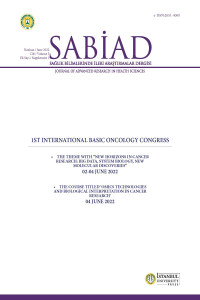Abstract
Objectives: The most significant barrier to treating epithelial ovarian cancer(EOC), is the late diagnosis and the emergence of chemotherapy resistance in
the early stages.The ineffectiveness of standard treatment protocols in advanced-stage cases highlights the value of individualized EOC treatment.Even
monozygotic(MZ) twins, with almost the same genotype in nature, can develop different phenotypic characteristics throughout life.
Materials-Methods: In this context, the peripheral blood and ovarian tissues of monozygotic twins who are discordant in terms of ovarian cancer and the
other healthy sibling who is a BRCA1 mutation carrier were compared in the study to analyze all RNA molecules transcribed at the genome level using
next-generation sequencing technology.Through analyzing the molecules transcribed in the whole genome,the genetic variations underlying the
development of ovarian cancer in a high-risk family bearing the BRCA1 mutation but only one of whom was found to have ovarian cancer were examined.
Results: As a result of the transcriptomic analysis of the total RNA of 6 samples obtained from the ovarian tissues and peripheral blood samples of MZ
twins with ovarian cancer and healthy sibling, the protein-encoding protein that shows expression changes in tissue and blood compared to healthy people
genes,lncRNAs,precursor-miRNAs and fusion-transcripts have been identified.Filtering procedures and expression change coefficients(log2Fc) were
calculated based on the expression data of identified ovarian cancer tumor markers CA125 and CA15-3.
Conclusions: According to our study the expression levels of 66 protein-coding genes,23 novel lncRNAs,9 miRNAs and,2 fusion transcripts were found to
vary in three groups and,these molecules are thought to be candidate molecules associated with epithelial ovarian cancer.
Keywords
monozygotic twins Epithelial Ovarian Cancer RNA Sequence Analysis Gene Expression Profiling
References
- Grozescu T, Popa F. Prostate cancer between prognosis and adequate/proper therapy. J Med Life. 2017;10(1):5-12
Abstract
Objectives: The most significant barrier to treating epithelial ovarian cancer(EOC), is the late diagnosis and the emergence of chemotherapy resistance in
the early stages.The ineffectiveness of standard treatment protocols in advanced-stage cases highlights the value of individualized EOC treatment.Even
monozygotic(MZ) twins, with almost the same genotype in nature, can develop different phenotypic characteristics throughout life.
Materials-Methods: In this context, the peripheral blood and ovarian tissues of monozygotic twins who are discordant in terms of ovarian cancer and the
other healthy sibling who is a BRCA1 mutation carrier were compared in the study to analyze all RNA molecules transcribed at the genome level using
next-generation sequencing technology.Through analyzing the molecules transcribed in the whole genome,the genetic variations underlying the
development of ovarian cancer in a high-risk family bearing the BRCA1 mutation but only one of whom was found to have ovarian cancer were examined.
Results: As a result of the transcriptomic analysis of the total RNA of 6 samples obtained from the ovarian tissues and peripheral blood samples of MZ
twins with ovarian cancer and healthy sibling, the protein-encoding protein that shows expression changes in tissue and blood compared to healthy people
genes,lncRNAs,precursor-miRNAs and fusion-transcripts have been identified.Filtering procedures and expression change coefficients(log2Fc) were
calculated based on the expression data of identified ovarian cancer tumor markers CA125 and CA15-3.
Conclusions: According to our study the expression levels of 66 protein-coding genes,23 novel lncRNAs,9 miRNAs and,2 fusion transcripts were found to
vary in three groups and,these molecules are thought to be candidate molecules associated with epithelial ovarian cancer.
Keywords
monozygotic twins Epithelial Ovarian Cancer RNA Sequence Analysis Gene Expression Profiling
References
- Grozescu T, Popa F. Prostate cancer between prognosis and adequate/proper therapy. J Med Life. 2017;10(1):5-12
Details
| Primary Language | English |
|---|---|
| Subjects | Clinical Sciences |
| Journal Section | Meeting Abstract |
| Authors | |
| Publication Date | August 9, 2022 |
| Submission Date | June 29, 2022 |
| Published in Issue | Year 2022 Volume: 5 Issue: S-1 |

